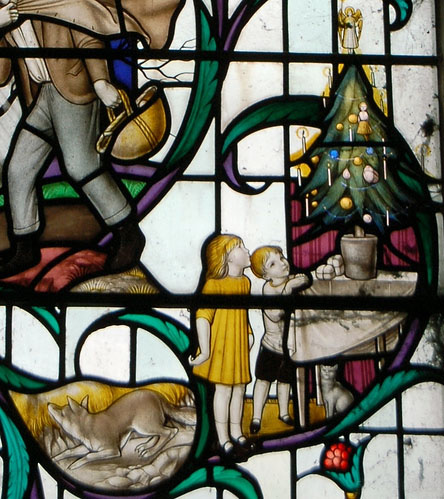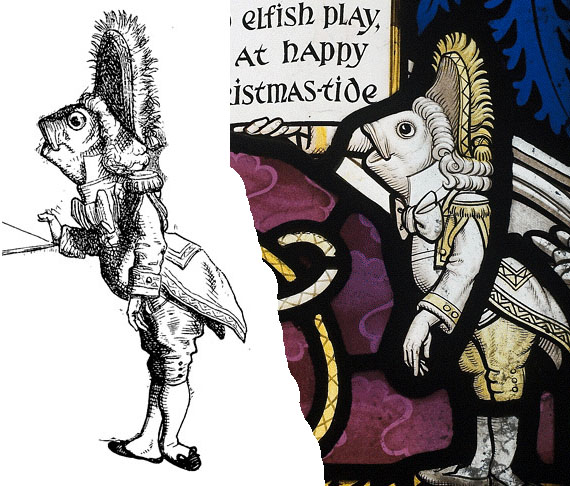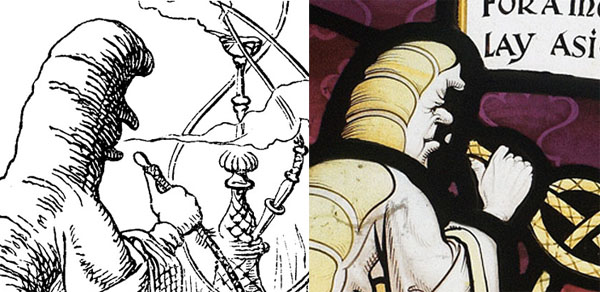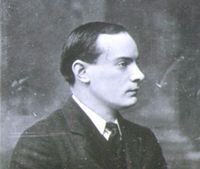June 29, 2007
Judith Schaechter website
At long last... finally... an actual website from the one and only Judith Schaechter.
Generous supply of images (well over a hundred panels shown) and nice big images at that.
She also has a long list of links - make sure to scroll down and check out the links in 'Inspiration'.
June 28, 2007
Toddington Church
recent arrival on flickr -
from the Bedfordshire Set of 'Buildingfan'
The East Window at Toddington Church, Bedfordshire, UK

By Christopher Webb, brother to Geoffrey Webb, designer of the Alice Window.

A nice, delicate illustrative style.
Check out the full set, as it contains a full window shot and more details.
June 20, 2007
Clarke after Clarke
A surprising find on Flickr.
Irish Rebellion Panel from merrionsq's Dublin Set

Created circa 1934 by the Harry Clarke Studio.
Currently located at Earlsfort Terrace Library UCD in Dublin, though it will be moving soon as the library is closing.
Note that it's the Harry Clarke Studio, but not Harry Clarke.
Harry Clarke died in 1930. This window was designed by Richard King.
So, what do I find so surprising?
The surprise comes from my own assumption that the Harry Clarke Studio had continued on ONLY in the realm of commissioned religious work and did not attempt any of the secular work that Clarke did in the last ten years of his life. Dazzling works culminating in what many see as his greatest acheivement, The Geneva Window.
So, I was surprised that I had never heard of this particular window by Richard King and The Harry Clarke Studio.
It must be noted that the prevailing opinion is that the "Harry Clarke Studio" had a precipitous decline after the death of Harry Clarke himself. The Rebellion panel was created just a few years after Clarke's death and the decline is not yet so evident, though it's obvious it had already set in.
The photo is fuzzy and may be over-saturated in terms of its color, but it's clear to my eye that the color work is not on a par with the Geneva Window. The coloring in the Rebellion Window is much more primary and the values are overall brighter and flatter. This becomes more evident with a side by side comparison with the Geneva Window.

The Rebellion panel has a much more straightforward red and blue palette (at least in the upper sections) rather than the amazing range of colors Clarke got through his mastery of etching and plating flashed glass. Most importantly, Harry Clarke was a true master in terms of his use of BLACK. It's true of his black and white illustration work and true of his stained glass. I've long thought that the best stained glass is done by those who can be masterful and bold in the use of black.
Nevertheless, the Rebellion panel does have some merits, especially in the two lowest panels. The general composition and drawing quality is on a very high level. and the 'special effects' work - i.e. the acid etching, painting, staining, and layering is very beautifully done.

I like the figure bursting up through the frame in the lower right. The 'special effects' that was such a signature of Harry Clarke is used to nice benefit here.

The figure is Kevin Barry, a young Volunteer who was executed by the British and became a key propaganda figure in the last years before Irish Independence.

The section I like the most is the lower left panel, which depicts the 1916 leaders at the GPO.
Everything about this panel seems to me on a higher quality than the others. The draftsmanship, the composition, and especially the color palette. Perhaps it's because these were more recent events being depicted that the designer felt a little more comfortable with this panel, and more passionate. He would have known who these men were and what they looked like - that might have made all the difference for him. This one panel seems much less like the 'faux-Harry Clarke' style that the Harry Clarke Studio turned into. I think there is even a glimmer of a style that could have evolved from the Harry Clarke style to a different but just as good Richard King style. Too bad it didn't happen that way.
[update Nov. 17, 2009 - Found a nice biographical article on the Mayo News website on Richard King. It seems like King's stint as the the 'after Harry Clarke' designer left him underrated. Definitely worthy of further study.]
The term, 1916 leaders at the GPO, refers to the taking of the General Post Office that preceded the Proclamation of the Irish Republic, all during the Easter Uprising.

Photos and links to info on a few of the figures in the panel -
| Thomas J. Clarke
| Padraig Pearse
| Eamonn Ceannt
|
| James Connolly
|
Joseph Plunkett
|
June 12, 2007
Johan Thorn-Prikker Video
Even though Johan Thorn Prikker (1869-1932) is widely regarded as one of the most influential stained glass artists of the last 100 years because of his influence on post WWII German stained glass artists from Georg Meistermann to Johannes Schreiter, it has always been difficult to find examples of his work. There are no books available I'm aware of (in the USA or in english at least) that catalog his work. Even on the web, there are just a smattering of images. There is virtually nothing at the English Wikipedia entry for Johan Thorn Prikker and only slightly more at the German Wikipedia entry for Johan Thorn Prikker.
So, this video contains more work of Thorn Prikker than I've ever seen before - with, alas, no information about the windows.
Up until now, I've been more interested in Thorn Prikker's Symbolist work than in his stained glass, but I'd only seen his more starkly minimalist stained glass. This video suggests to me that some of the Symbolist and Art Nouveau influences were in the stained glass as well, at least the earlier stained glass.
video from Stained Glass Elements, associated with the Dutch stained glass artist, Frans de Heer
June 05, 2007
'Alice in Wonderland' - a study in translation
I saw a postcard of this Mad Hatter panel a few years ago and always suspected it was part of a larger program of panels. Indeed it is and the full Alice in Wonderland Window can be seen as part of the website for the church where it's located - All Saints Church in Daresbury, England.

SG photography by John Eastwood
It turns out that the Mad Hatter panel is in the center of 5 small 'Alice character' panels below a larger Nativity scene.

The window was created in 1935 to mark the 1932 centenary of the birth of Lewis Carroll and was created at All Saint's because it was the parish where Carroll was born (as Charles Dodgson). Lewis Carroll and Alice Liddell are depicted in the leftmost lancet. The stained glass is by Geoffrey Webb, who was a student of Charles Eamer Kempe. Stylistically, especially as regards the nativity scene, that makes sense as Kempe tended toward this kind of color scheme featuring the starkly white figures with shots of color in the clothing and background. (Bio of Geoffrey Webb - scroll down about a quarter of the page)
The design for the all of the 'Alice in Wonderland" characters are, of course, based on the famous illustrations designed by John Tenniel. I thought it would be interesting to get a detailed look at the how closely the original illustrations, designed by John Tenniel were translated into stained glass.
Mostly pictures, with some written commentary - going left to right -
White Rabbit and Dodo Panel
The stained glass panel.

The original illustrations in full.

As expected, the stained glass figures have less cross hatching and feature more thick black lines. All the characters are surrounded by a fairly thick line of black. The translation to color is not jarring seeing that all the characters are on clear glass with accents in yellow silverstain. Keeping the characters all white against a dark color background gives more of the impression that the figures have stepped off the pages of the printed book. The yellow adds color which keeps them from looking too flat, yet the use of stain is subtle and doesn't overwhelm.
White Rabbit illustration and stained glass designs side by side

Dodo designs side by side

Lizard designs side by side

Caterpiller and Fish Footman Panel


This example shows how the SG designer will sometimes take an element in the illustrations and transform it to something more conventionally stained glass like. I refer to the hookah pipe in the stained glass which, compared to the illustration, curves in a much more symmetrical fashion, much more like a decorative knot pattern one might find in a stained glass window.
Fish Footman designs side by side

Throughout, the hands are proportionally larger in the stained glass figures and more clearly delineated. They are also, to my eye, more noticably 'human' hands. The hands are human in the prints as well, but the hands in the prints are smaller and sketchier, not calling attention to themselves as much. The Frog Footman is a good example.

The caterpillar is unique in that the SG designer sees fit to delineate a face where there was only a shadow in the original illustration.
Mad Hatter, Dormouse and March Hare Panel

The Mad Hatter is the one character whose design does not derive directly from any of the Tenniel illustrations. It's curious since the Mad Hatter is depicted five times in 'Alice in Wonderland', more than any other character save Alice herself.

The head of the March Hare is derived from the main tea party scene though the Hare's body is original to the stained glass. The dormouse is roughly taken from the main tea party scene, though again the SG designer makes the hands larger and curiously more realistic human-looking hands.

Duchess, Griffin and Mock Turtle Panel


Note that only the head of the Griffin is derived from the above illustration(reversed) while the design of the body and wings of the griffin is new to the stained glass and again are more 'stained glass like, note the symmetry. The wings, especially, look more like Kempe than Tenniel.
Duchess designs side by side

Mock Turtle designs side by side

Note the linework. Both are beautiful in their own way but they are different interpretations. Both are, in fact, translations of an original design by Tenniel.
Many assume the original illustrations are pen and ink drawings by Tenniel, but they aren't. In the printed version, the linework was interpreted by the wood engraver, in this case by the Dalziel Brothers. Tenniel drew in pencil on a whitewashed block of wood and the lines were created by carving out the areas of white and leaving the areas representing black lines raised on the wood block.
In the case of the stained glass, the linework was interpreted by painting black lines on glass with a brush. With a brush, there is a more curving line and a greater emphasis on thin to thick lines.
Knave and Queen of Hearts Panel

This is the only panel that features two full figures coming from the same illustration.

Queen of Hearts designs side by side

One thing that pops out to me is how the ornamentation on the clothing has changed from illustration to stained glass. The stained glass features heart designs on the clothing while the printed illustration does not.
Knave of Hearts designs side by side

'Alice in Wonderland' - a study in translation
I saw a postcard of this Mad Hatter panel a few years ago and always suspected it was part of a larger program of panels. Indeed it is and the full Alice in Wonderland Window can be seen as part of the website for the church where it's located - All Saints Church in Daresbury, England.

SG photography by John Eastwood
It turns out that the Mad Hatter panel is in the center of 5 small 'Alice character' panels below a larger Nativity scene.

The window was created in 1935 to mark the 1932 centenary of the birth of Lewis Carroll and was created at All Saint's because it was the parish where Carroll was born (as Charles Dodgson). Lewis Carroll and Alice Liddell are depicted in the leftmost lancet. The stained glass is by Geoffrey Webb, who was a student of Charles Eamer Kempe. Stylistically, especially as regards the nativity scene, that makes sense as Kempe tended toward this kind of color scheme featuring the starkly white figures with shots of color in the clothing and background. (Bio of Geoffrey Webb - scroll down about a quarter of the page)
The design for the all of the 'Alice in Wonderland" characters are, of course, based on the famous illustrations designed by John Tenniel. I thought it would be interesting to get a detailed look at how closely the original illustrations, designed by John Tenniel, were translated into stained glass.
Mostly pictures, with some written commentary - going left to right -
White Rabbit and Dodo Panel
The stained glass panel.

The original illustrations in full.

As expected, the stained glass figures have less cross hatching and feature more thick black lines. All the characters are surrounded by a fairly thick line of black. The translation to color is not jarring seeing that all the characters are on clear glass with accents in yellow silverstain. Keeping the characters all white against a dark color background gives more of the impression that the figures have stepped off the pages of the printed book. The yellow adds color which keeps them from looking too flat, yet the use of stain is subtle and doesn't overwhelm.
White Rabbit illustration and stained glass designs side by side

Dodo designs side by side

Lizard designs side by side

Caterpiller and Fish Footman Panel


This example shows how the SG designer will sometimes take an element in the illustrations and transform it to something more conventionally stained glass like. I refer to the hookah pipe in the stained glass which, compared to the illustration, curves in a much more symmetrical fashion, much more like a decorative knot pattern one might find in a stained glass window.
Fish Footman designs side by side

Throughout, the hands are proportionally larger in the stained glass figures and more clearly delineated. They are also, to my eye, more noticably 'human' hands. The hands are human in the prints as well, but the hands in the prints are smaller and sketchier, not calling attention to themselves as much. The Frog Footman is a good example.

The caterpillar is unique in that the SG designer sees fit to delineate a face where there was only a shadow in the original illustration.
Mad Hatter, Dormouse and March Hare Panel

The Mad Hatter is the one character whose design does not derive directly from any of the Tenniel illustrations. It's curious since the Mad Hatter is depicted five times in 'Alice in Wonderland', more than any other character save Alice herself.

The head of the March Hare is derived from the main tea party scene though the Hare's body is original to the stained glass. The dormouse is roughly taken from the main tea party scene, though again the SG designer makes the hands larger and curiously more realistic human-looking hands.

Duchess, Griffin and Mock Turtle Panel


Note that only the head of the Griffin is derived from the above illustration(reversed) while the design of the body and wings of the griffin is new to the stained glass and again are more 'stained glass like, note the symmetry. The wings, especially, look more like Kempe than Tenniel.
Duchess designs side by side

Mock Turtle designs side by side

Note the linework. Both are beautiful in their own way but they are different interpretations. Both are, in fact, translations of an original design by Tenniel.
Many assume the original illustrations are pen and ink drawings by Tenniel, but they aren't. In the printed version, the linework was interpreted by the wood engraver, in this case by the Dalziel Brothers. Tenniel drew in pencil on a whitewashed block of wood and the lines were created by carving out the areas of white and leaving the areas representing black lines raised on the wood block.
In the case of the stained glass, the linework was interpreted by painting black lines on glass with a brush. With a brush, there is a more curving line and a greater emphasis on thin to thick lines.
Knave and Queen of Hearts Panel

This is the only panel that features two full figures coming from the same illustration.

Queen of Hearts designs side by side

One thing that pops out to me is how the ornamentation on the clothing has changed from illustration to stained glass. The stained glass features heart designs on the clothing while the printed illustration does not.
Knave of Hearts designs side by side

June 01, 2007
More and more from Flickr
Simply put, if you like stained glass (at least English stained glass) and so you like to browse through hundreds of images of stained glass, full shots and details, then this Stained Glass Set by Lawrence OP on Flickr is what you've been waiting for.
My favorite, as usual - the accidental surrealism of the English jumble window - from Waterperry Church in Oxfordshire.





